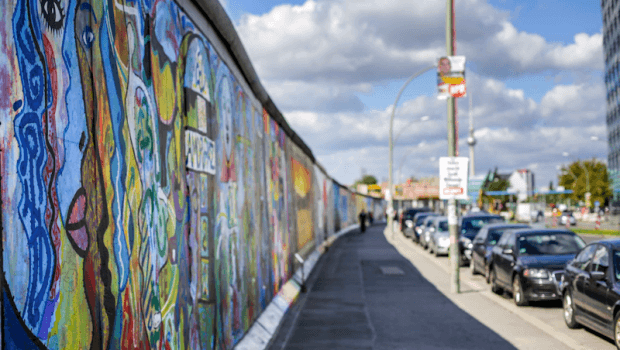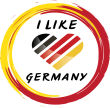
The famous Berlin Wall was a barrier that divided Berlin from the year 1961 to 1989. It was built by the German Democratic Republic, is also known as East Germany, at that time, and it completely cut off West Berlin from the surrounding East Germany and East Berlin until 1989 when government officials opened it. The Berlin wall was officially called the “Anti-Fascist Protective Wall” by the authorities who implied that the West Germany, in particular, was considered to be “fascist.” It was also called as the ‘wall of shame’ while showing complete disproval of the restriction of the wall to freedom of movement. Modern Berlin is home to famous universities, museums, and is a major tourist destination with several industries.
Location
Modern Berlin is the capital city of Germany and is one of the most populous city proper in the European Union. The Berlin Wall seperated the East Germany from the West Germany; when it was built. The fall of the Berlin wall gave way to the reunification of Germany which was formally concluded on 3rd October 1990.
Weather
Berlin is known to have a maritime temperate climate system. There are mild influences of the continental climate, because of its central position; with trusts being common during winter has also been observed. There have also been significant temperature differences between seasons more than typical for many oceanic climates. The summers are warm and often humid with an average temperature of 22 to 25 degrees Celsius. Snowfall occurs mainly from December to March at the time of winter.
History
In the early 20thcentury, Berlin had become one of the fertile grounds for German Expressionist movement. Also in 1933, Adolf Hitler and the Nazi party came to power. They destroyed the Jewish community which resulted in a massive migration between 1933 and 1939. During the time of World War 2 large parts of Berlin was destroyed. By the end of the war in Europe in May 1945, Berlin received a huge number of refugees from the provinces in the East. This lead to the victorious powers dividing the city into four sectors. The western allies formed the West Berlin while the Soviet sector formed the East Berlin.
The founding of the two German states leads to a Cold War. East Germany territory surrounded the West Berlin, and the East Germany proclaimed the eastern part to be its capital. This was however not accosted by the western powers. This happened in 1961, East Germany building the Berlin Wall between the East and West Berlin. Berlin got completely divided. With an epic struggle in 1989, the cold war came to an end and due to the inccreading pressure from the East German population, the Berlin Wall fell on 9th November and was mostly demolished. Today, you can see east side gallery preserving a significant portion of the wall.
The wall:
The barrier called the Berlin Wall that divided Germany into East and West was built on the night of August 12-13 1961. Originally, the wall was constructed of barbed wire which was eventually replaced by a series of concrete walls which lay up to 15 feet high. It was topped with barbed wires and guarded by watchtowers, guns, and mines. By the end of the 1980s, the wall along with the electrified fences extended up to 45 km through Berlin, which ended up dividing two parts of the city.
The infamous Berlin Wall started becoming a symbol of the Cold War’s division of East from West Germany and of the Eastern from Western Europe. At this time around 5,000, East Germans had managed to cross the Berlin wall to reach West Berlin safely. Also, many lost their lives in an attempt to escape and were killed during the crossing of the wall.
East Germany with its hard-line communist leadership was forced into power in October 1989 during the time of democratization which had swept through Eastern Europe. On November 9 the East German government decided to open the borders and openings were made in the Berlin wall through which East Germans can travel freely to the west. The wall then ceased to function as a political barrier between the East and West Germany.
Travelling in the city
Berlin has a good public transport system which will take you almost anywhere you want to go. Taxis are usually easy to catch, and you can also get bike rentals without any hassle. This allows an easy tour of the city as per your convenience. No matter what your easy mode of transport is, train, bike, car, mobility in Berlin is very simple.
Why visit
Berlin is one of the cities in the European Union, which requires undivided attention. The capital city, Berlin is very well known for its exceptional attractions, cultural scenes and a way of life that is both faced paced and relaxed.
You get to experience the rich historical buildings along with modern architecture making the city stand out from the rest. The beautiful sight from the Brandenburg Gate to the Federal Chancellery can show you the story of an entire nation. The city is home to all the major government buildings, most notably the German parliament.
Berlin is a city famous for its art, artists, and museums. With over 170 galleries, you can have a fun time exploring the history of the city. Several theatres are specialising in plays that offer stage entertainment in all its forms. Apart from this, the famous Kurfürstendamm, grand old Friedrichstrasse and several independent boutiques around the Hackesche Höfe can provide the shopaholic in your endless scope for fun and experimentation.
Berlin also has a relaxed side to it. With lots of open spaces, you can be sure that no city in Germany is greener that Berlin with its rich forests, lakes, and sprawling parks. Here you can enjoy the sunshine and the summer night leaving you awestruck.
Major Attractions:
- The Brandenburg Gate: this is definitely the defining monument in the city. This 26-meter high sandstone statue was berlin’s first neoclassical structure which is very well known for its four horse chariot and the six large columns on both sides forming five passages which are for use by traffic along with the two buildings used by toll-collectors and guards.
- Museum Island: this is an island between the river Spree and the Kupfergraben, a 400-meter-long canal. It was built around 1830 to house the crown jewels and other royal treasures. Adding an extra element is the fact that the island is entirely devoid of any traffic.
- Charlottenburg Palace and Park: it was one of the most important places of residence for German royalty. It was built in 1764, and the visitors get a glimpse of the splendour in which the Prussian kings and electors lived.
- The Gendarmenmarkt: is one of the largest squares in Berlin. It is dominated by three significant historic buildings- the Konzerthaus, the French Cathedral (Französischer Dom), and the Berlin Cathedral (Berliner Dom) – which together form one of the most picturesque corners of the city. If you are planning to visit in winter, be sure to plan your visit at the time of the Gendarmenmarkt’s traditional Christmas Market.
What else is around?
- POTSDAM: The place is a must visit to enjoy the amazing castle Sansoussi, which lets you experience an exciting cultural perspective. The place is quite easy to reach, by train or by car and has peaceful spaces without erasing the urban touch. For that perfect day trip, Potsdam is the one to look forward to.DRESDEN & THE SAXON SWITZERLAND NATIONAL PARK: The Saxon Switzerland National Park near Dresden is the perfect location to be if you are interested in hiking. You will get in touch with the loving side of nature and can have a very good time in the mountains.
- LEIPZIG: The place has come to be known as the ‘New Berlin’ because of its earlier industrial warehouses, cheap rent and renowned art and schools. A short train ride from Berlin will lead you to Leipzig, a growing and vibrant culturally interesting place with unique off-location adventurous activities to be done.
- HAMBURG: Get on a train to Hamburg to feel the fresh air, adore the architecture in the city centre and walk around the Binnenalster. Also, a must visit here is the Red Light District in the evening, the perfect place to get wasted and enjoy.
- THE BALTIC SEA: For all those looking for calmness and authenticity, the Baltic Sea is the place to be. The place is called Hiddensee, which is an island of about 17 kilometres long. It is full of excitement and adventure. It became a famous 20th-century artist colony.
- SPREEWALD: A visit to the place is very popular especially during the time of Easter. It takes about an hour to reach the Spree, which is an artificial forest and lowland that mainly consist of meadows and ramifications of the Spree. You can enjoy the pastoral atmosphere on a mild sunny day.
